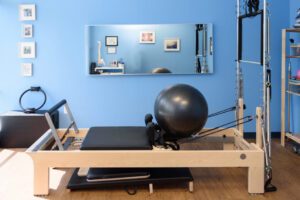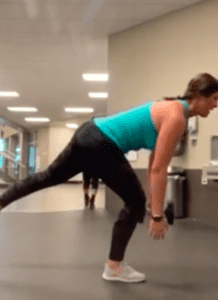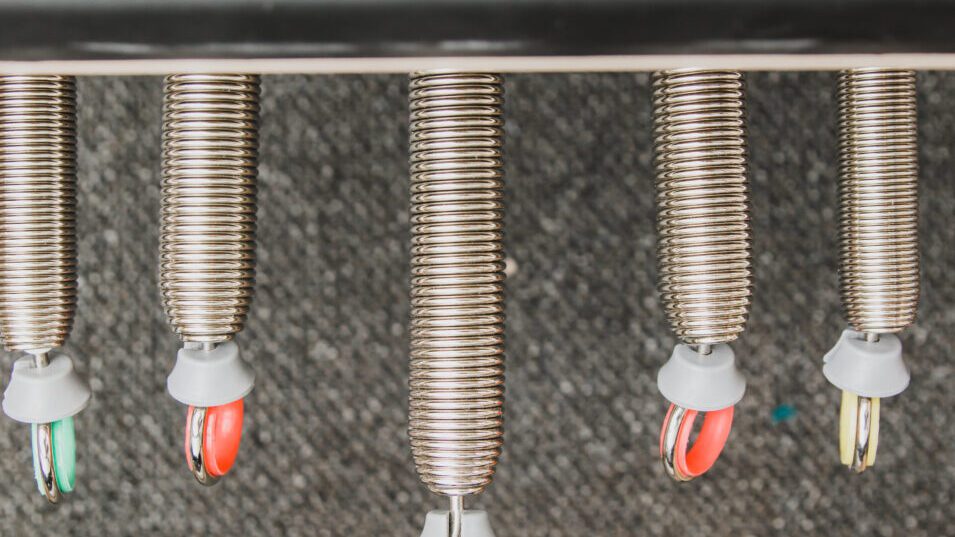How Pilates Builds Self-Awareness
For nearly a decade I have relied on Pilates based exercises to help teach my patients about their bodies. My interest in Pilates started way back when I was working in neurologic rehab, primarily with individuals who experienced a stroke or spinal cord injury. Sadly, these injuries result in a disconnect between the brain/spinal cord and muscles. That said, rehab focuses on trying to reestablish connection.
Re-learning how to move requires a TON of practice (some evidence suggest that upwards of 500 hours of practice is required to invoke an unconscious motor program).
Interestingly, rebuilding connection is complex. And most surprising of all, I find that it applies to so many rehab clients, not just those who suffer from a devastating neurologic injury.
Massed Practice + Input
Remember the 500 hours of practice we referenced above? Yea, that’s quite literal. And while repetition is paramount, so is input. Stimulation, aka input, can come in the form of verbal or tactile cueing, load or direction. In Pilates, we can easily and effectively adjust all of the above to facilitate muscular activation through various different verbal and tactile cues.
“The accessibility to the pre-requisites of re-learning became the catalyst for my love of Pilates.” – Dr. Crawford, PT, DPT, COMT, CMTPT
By utilizing Pilates principles of alignment, breath, centering and precision, I witnessed sprouting of muscle patterns that weren’t otherwise achieved. With that said, when transitioning from neurologic rehab to orthopedics and chronic pain, the application of Pilates was painfully obvious.
Pilates offers what no other exercise regimen brought to the table: feedback and increased self-awareness in addition to practice.
To understand this we must understand the Pilates principles
Joseph Pilates created the technique “Contrology” to control and unify the body, mind and spirit. After his passing, the following principles were extracted from his teachings:
-
- Concentration – During Pilates the focus is on the entire body to ensure smooth movements. This is hard. In Pilates exercise, technique and performance is, in many respects, more important than the exercises themselves.
- Control – Every exercise in Pilates must be done with control. Fundamentally it’s about you being in control of your body.
- Centering – To effectively control your body you must have a starting place and that place is your center. You’ll often hear this called the ‘powerhouse’ which is a term that means your center and encompasses the abs, upper and lower back, hips, butt and inner thighs. All movement in Pilates should begin from your center, your powerhouse and flow out to the limbs.
- Flow – Exercises within Pilates are intended to flow into each other to help build strength and stamina. The use of appropriate transitions and economy of movement is highly prized and is one of the key things that differentiates novice and advanced practitioners.
- Precision – Pilates aims for precise and perfect movement. With regular Pilates and expert instruction this precision will eventually become second nature and carry over into everyday life. An expert Pilates instructor can tell a lot about a person by simply watching them walk.
- Breathing – Typically in Pilates you focus on breathing out with effort and in on the return. Coordinating breathing with movement is an important part of Pilates and good instructors will continually remind you when to breathe in and when to breathe out. Like everything in Pilates you should concentrate on each breathe and feel the engagement of your powerhouse.
A Feedback System
I want you to think all the way back to kindergarten (okay, most of you don’t have a memory from that year but likely you’ve helped your child through early school years). Remember learning how to write? Initially you trace dotted lines on a piece of paper. Those dotted lines are squeezed between horizontal lines. Your feedback was based on your ability to stay on the dotted lines and between the horizontal lines. Eventually we begin to draw the letters between horizontal lines without anything to trace and eventually drawing the letters without lines to keep you level.
Feedback is required to learn
Fun fact: Mat Pilates is a derivative of Pilates reformer exercises adjusted for being on the floor
In Pilates, feedback comes from the Reformer (see below), the equipment used for true Pilates. The reformer provides reference to where your body is in space by means of straps, ropes, pads and the footbar, to name a few. Additionally, resistance is created with springs that also provide feedback. When we lack control, the springs will take slam the carriage (moving piece) into the bumper (where the springs attach, pictured below) or poor control of speed when moving through various repertoires. Auditory as well as sensorial feedback is inherently built into this system.
 Pilate Reformer – notice the ropes, straps and shoulder pads; foot bar (opposite of ball)
Pilate Reformer – notice the ropes, straps and shoulder pads; foot bar (opposite of ball)

Springs/Resistance
Burgeoning Self-Awareness
Let’s put this all together!
- Pilates is based on 6 principles: concentration, control, centering, flow, precision and breathing.
- Re-learning requires mass practice (between 40-50 thousand repetitions, just an aside) and graded stimulation.
- Feedback is key!
Conclusion: the combination of principles + practice + feedback is unlike any other form of exercise.
Other exercise: Functional Training
Functional training is great in theory as it involves activities that the brain is used to performing. Interestingly, the brain is phenomenal at re-learning activities that its familiar with. Movements like a squat and step up are comfortable for the brain. Unfortunately our bodies are exceptional at storing energy and compensations. So if you’ve been compensating to preserve energy and your motor program involves delayed or non-existent activation of the hip muscles, for example, cheating occurs. That said, if we continue to train in the same manner that we function in, we are training faulty patterns.
Other exercise: Compound Movements
Compounded movements are another category of exercise that are very functional as they involve the movement of multiple joints at a time. Many would argue this as the best way to re-learn a movement. I, on the other hand, would argue that for those who are extremely disconnected or unaware, it’s too much, too soon. Oftentimes, compounded movements over-stimulate the brain and delay learning.
This skill (or motor program) requires a lot of coordination. The precipitate of coordination is control. In order to be able to coordinate multiple movements at a time, one must be able to isolate and control individual units.
Watch this video to see what an example of compound movement looks like

Single leg deadlift-side lunge combo
(in this exercise, coordination is required been the ankle-knee-hip as well as core and shoulder/arm)
*As an aside, a motor program is a fancy way for describing a sequence of muscles movements directed to accomplish a skill.
Pilates serves as a barometer for good movement
First, Pilates is applicable no matter where you are in life. The seasoned athlete and the out of shape, middle aged beginner can benefit from the exact same class. Second, the principles alone function to optimize our relationship with movement. Third, and in my opinion the most important, the reformer serves as a feedback system that few other forms of exercise afford.
With all of that said, improved self-awareness yields greater control through activities of everyday life in addition to occupational and recreational activities. Every opportunity to workout on the Pilates reformer affords a persona improved knowledge of where their body is in space. Additionally, they gain greater coordination and endurance of postural muscles that parlay into lifting heavy boxes at home or when working out at the gym.
The posture, alignment and MOST importantly, breathing mechanics learned through Pilates facilitate optimal performance in everyday life.
Want more reasons to try Pilates? Check out Dr. Crawfords blog 8 Reasons YOU Should Do Pilates by Dr. Sarah Crawford to learn more!
About the author:

Dr. Sarah Cash Crawford, PT, DPT, COMT, CMTPT, is a Physical Therapist and Certified Pilates Instructor. She has been a practicing physical therapy for over nine years. With a background in neurologic rehabilitation, manual therapy and a specialty in treating chronic pain, Dr. Crawford began studying Pilates to further expand her treatment options to help patients overcome physical limitations. Dr. Crawford is the founder of the Anchor Wellness Center & Anchor Wellness, Inc., an integrative health practice that specializes in physical therapy and pilates.

